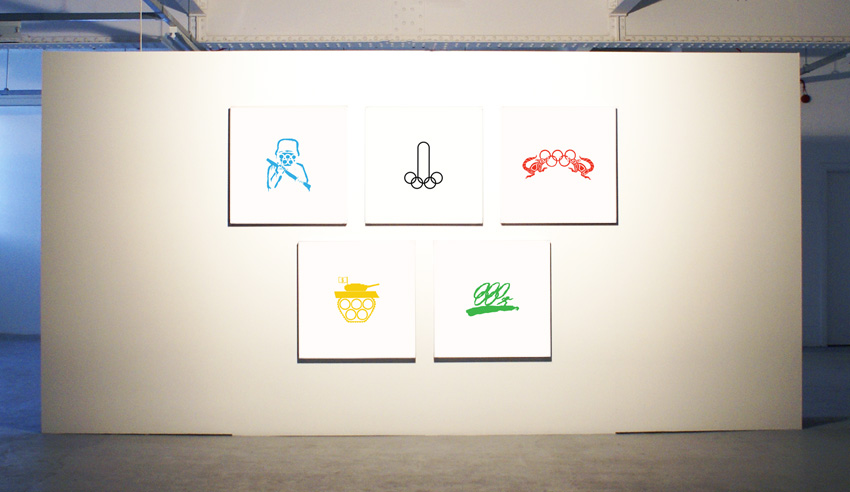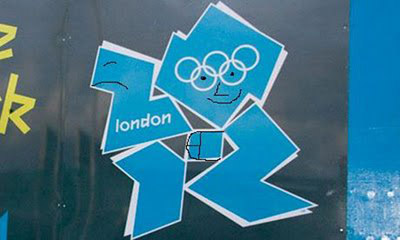|
While in Vancouver shortly before the 2010 Winter Olympics I noticed some imaginative ways the Olympics symbol was being subverted in graffiti and on stickers, banners and blogs. But despite the five rings being, as Angus Carlyle puts it, 'ripe for détournement', I was unable to find similar graphic subversions on public display in London before the 2012 Games, so I made use of what I'd seen in Vancouver and found online for this installation. The perimeter wall around the London Olympic site had so many coats of blue paint that I think the graffitists eventually just gave up. It seemed that the suppression of protest – at least in the form of publicly visible graphics – had been particularly successful in London, though in the final days before the 2012 Games the graphic subversions blossomed and new, witty and poignant images emerged daily (see below). It may be unclear how far police will take their powers under Section 22 of the London Olympic Games and Games Act 2006 to use "reasonable force" to enter "land or premises" to remove and destroy protest materials, but the fact that the legislation exists is worrying evidence of the IOC's power to "shape a country's domestic policy, at least in the short term." (Helen Lenskyj) There is already evidence of a disproportionate crackdown on graffiti, with long custodial sentences handed out even for first offences. Appropriately enough in relation to both the "No Olympics on Stolen Native land" campaign and Vancouver's appropriation of an (inappropriate) Inuit symbol for its logo, the CEO of the Vancouver Organizing Committee for 2010 reportedly stated that "The five Olympic rings could be used to sell snow to the Eskimos." There is no doubt that, as George Monbiot put it in the Guardian, "The Games have become a license for land grabs." And the value for sponsors of having their logos associated with the Olympics and of the restrictions on competition within Olympic sites is massive, regardless of how little their products might relate to notions of good health and social responsibility, as in the case of McDonalds and Dow Chemicals. I was delighted to discover that one of the graphic appropriations of the rings I found was by an artist from the same indigenous Canadian community in which I recently worked on an endangered language project. Angela Sterritt is a Gitxsan artist (and now a CBC broadcaster) whose graphics were widely used by the No 2010 campaign, and she graciously allowed me to include her Wolves not Sheep. The image of a figure running from the rings was used extensively by the Bread Not Circuses campaign against Toronto's (failed) bid in 2008, but this and the other graphics remain anonymous, despite my efforts to trace their origins. Booing sounds from sound effects libraries simultaneously give voice to protests against the games and reflect the aggression that seems to be an integral part of high-level sport and, at times, of its spectators. Sometimes, as George Orwell observed, "Serious sport… is war minus the shooting." Running throughout the piece is an electronic tone that seems to rise continuously in pitch. This is an illusion, of course – a sound that truly got higher and higher in pitch would soon go above the range of human hearing and become inaudible. The tension engendered by the rising tone suggests both the relentless hype that follows the Games around the world and the often unchallenged assumption of the benefits of endless progress in technology, culture and physical performance. The (illusory) public image of the Games relies heavily on the ideals of goodwill, social development, international peace and brotherhood to mask the underlying commercialism and profiteering of what Christopher Shaw refers to as "the Olympic machine".
|

